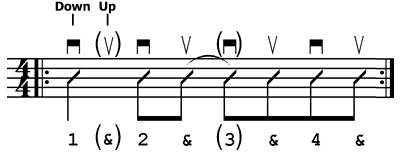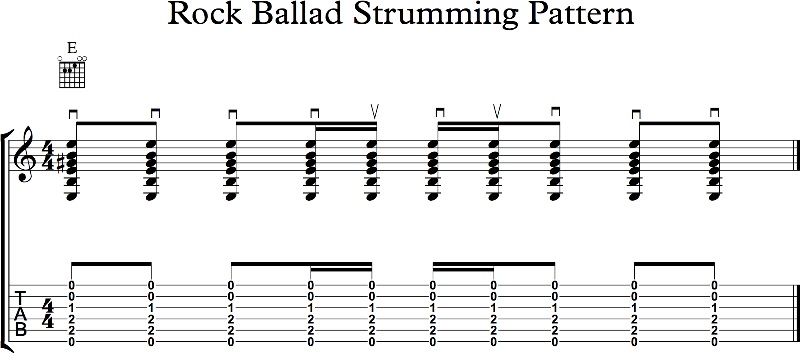Learning to properly strum the guitar is something a lot of beginning guitar players neglect because they concentrate so hard on making their fingers work the way they want them to work. Ironically, a lot of beginning guitar players have the most trouble with strumming, which can hinder their playing later on, just as they’re beginning to master melodies and chords with their fret hand. Here are a few Helpful Guitar Strumming Tips For Beginners to help get you working on the rhythmic aspect of your playing while you’re learning to play chords and melodies.
First and foremost, don’t wait to start working on your strumming. Putting it off too long will only make it harder later on, after you’ve mastered some chords and you find you still feel awkward strumming. Practice strumming while you’re learning chords. A good way to do this is to play a progression of the chords you learn and assign a specific strum pattern to the chords. Not only does this reinforce any new chords you’ve learned, it helps you apply those chords in a real playing situation. Take a look at the visual below. This is a very common strum pattern that shows the indicators for up and down strumming. Start with this and hit the strum patterns on the count shown. Count as you play until you get a feel for it.
 Check out this VIDEO GUITAR LESSON ON STRUMMING
Create variety in your strum patterns by alternately letting chords ring and overlap with using the fleshy part of your hand to quickly mute the strings, creating a percussive effect. When you combine these two techniques in conjunction with a set strum pattern, you’ll hear how that strum pattern seems to take on a life of its own.
One of my favorite guitar strumming tips for acoustic is to strum near the bridge of the guitar. This isn’t something you want to do all the time, but it does produce a tone that mimics an electric guitar and can be useful for adding color to a strum pattern. The tone here is crisper but not as loud. Conversely, strumming closer to the neck of the guitar produces a deeper, richer tone. Combining the two during a strum pattern creates a nice sound variety that can give an old song a new coat of paint.
Always vary the direction of your strums. Constantly strumming down or up can make any song sound dull. You may find it difficult to get creative with patterns at first, so try a couple of the patterns below. Mix and match them and see what you can come up with. After a bit of practice, strumming will begin to come natural and you’ll find yourself developing a style you’re familiar with.
Check out this VIDEO GUITAR LESSON ON STRUMMING
Create variety in your strum patterns by alternately letting chords ring and overlap with using the fleshy part of your hand to quickly mute the strings, creating a percussive effect. When you combine these two techniques in conjunction with a set strum pattern, you’ll hear how that strum pattern seems to take on a life of its own.
One of my favorite guitar strumming tips for acoustic is to strum near the bridge of the guitar. This isn’t something you want to do all the time, but it does produce a tone that mimics an electric guitar and can be useful for adding color to a strum pattern. The tone here is crisper but not as loud. Conversely, strumming closer to the neck of the guitar produces a deeper, richer tone. Combining the two during a strum pattern creates a nice sound variety that can give an old song a new coat of paint.
Always vary the direction of your strums. Constantly strumming down or up can make any song sound dull. You may find it difficult to get creative with patterns at first, so try a couple of the patterns below. Mix and match them and see what you can come up with. After a bit of practice, strumming will begin to come natural and you’ll find yourself developing a style you’re familiar with.


 If learning songs on guitar is your goal, I recommend you to check out these courses:
GUITAR SONG COLLECTION
If learning songs on guitar is your goal, I recommend you to check out these courses:
GUITAR SONG COLLECTION
Strumming Tips For Beginners
 Check out this VIDEO GUITAR LESSON ON STRUMMING
Create variety in your strum patterns by alternately letting chords ring and overlap with using the fleshy part of your hand to quickly mute the strings, creating a percussive effect. When you combine these two techniques in conjunction with a set strum pattern, you’ll hear how that strum pattern seems to take on a life of its own.
One of my favorite guitar strumming tips for acoustic is to strum near the bridge of the guitar. This isn’t something you want to do all the time, but it does produce a tone that mimics an electric guitar and can be useful for adding color to a strum pattern. The tone here is crisper but not as loud. Conversely, strumming closer to the neck of the guitar produces a deeper, richer tone. Combining the two during a strum pattern creates a nice sound variety that can give an old song a new coat of paint.
Always vary the direction of your strums. Constantly strumming down or up can make any song sound dull. You may find it difficult to get creative with patterns at first, so try a couple of the patterns below. Mix and match them and see what you can come up with. After a bit of practice, strumming will begin to come natural and you’ll find yourself developing a style you’re familiar with.
Check out this VIDEO GUITAR LESSON ON STRUMMING
Create variety in your strum patterns by alternately letting chords ring and overlap with using the fleshy part of your hand to quickly mute the strings, creating a percussive effect. When you combine these two techniques in conjunction with a set strum pattern, you’ll hear how that strum pattern seems to take on a life of its own.
One of my favorite guitar strumming tips for acoustic is to strum near the bridge of the guitar. This isn’t something you want to do all the time, but it does produce a tone that mimics an electric guitar and can be useful for adding color to a strum pattern. The tone here is crisper but not as loud. Conversely, strumming closer to the neck of the guitar produces a deeper, richer tone. Combining the two during a strum pattern creates a nice sound variety that can give an old song a new coat of paint.
Always vary the direction of your strums. Constantly strumming down or up can make any song sound dull. You may find it difficult to get creative with patterns at first, so try a couple of the patterns below. Mix and match them and see what you can come up with. After a bit of practice, strumming will begin to come natural and you’ll find yourself developing a style you’re familiar with.


 If learning songs on guitar is your goal, I recommend you to check out these courses:
GUITAR SONG COLLECTION
If learning songs on guitar is your goal, I recommend you to check out these courses:
GUITAR SONG COLLECTION